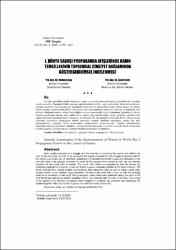| dc.contributor.author | Işık, Mehmet | |
| dc.contributor.author | Eşitli, Şakir | |
| dc.date.accessioned | 2019-10-20T21:12:29Z | |
| dc.date.available | 2019-10-20T21:12:29Z | |
| dc.date.issued | 2015 | |
| dc.identifier.issn | 0378-2921 | |
| dc.identifier.uri | http://www.trdizin.gov.tr/publication/paper/detail/TVRnMk5EUTJOZz09 | |
| dc.identifier.uri | https://hdl.handle.net/11421/18949 | |
| dc.description.abstract | Savaşlar genellikle erkekler tarafından, kadın ve çocukları korumak amacıyla yürütülen bir mücadele olarak resmedilir. Bununla birlikte yaşanan işgücü kaybının telafisi, cephe gerisindeki faaliyetlerin idamesi, savaşan erkeklerin motivasyonu gibi nedenlerle kadınların bu mücadeleye destek olması başarı için hayati öneme sahiptir. Ancak verilen destek karşılığında kadınların toplumsal rollerinde herhangi bir değişiklik vaat edilmez. Kadından istenen, erkeğe bağımlılığını ve onun karşısındaki ikincil konumunu pekiştiren iyi bir eş, kendini çocuklarına adayan anne, mutlu bir ev hanımı gibi ataerkil rolleri yerine getirmesi yanında artan işgücü ihtiyacını karşılamak üzere iş hayatına katılmasıdır. Bu kapsamda bu çalışmada Birinci Dünya Savaşı yıllarında yayımlanan propaganda afişleri arasından rastgele örneklem metoduyla seçilen beş afiş, göstergebilimin sağladığı analiz araçlarından yararlanılarak çözümlenmiştir. Yapılan çözümlemeler sonucunda afişlerin, geleneksel toplumsal cinsiyet rollerini koruyacak ve yeniden üretecek şekilde dolayısıyla da erkek egemen cinsiyetçi düzeni destekler biçimde tasarlandığı görülmüştür. | en_US |
| dc.description.abstract | Wars usually portrayed as a struggle with the intention of protecting the woman and children by man. At the same time, in order to be successful, the support of women for this struggle is become vital for the reasons such as the loss of workforce, maintenance of activities behind the façade and motivation of the men who fight in the struggle. However, in return for the support of the woman to man, not any changes promised for the social roles of women. The social roles which are requested by man for women are reinforcing dependence of women to man and fosters women& s secondary position in the social structure. The things expected from woman besides accomplishing their patriarchic roles as such as being a good wife, devoted mother to her children, happy housewife, are also to join work life in order to meet the growing needs of the workforce. In this study, five propaganda posters which were published during the years of the First World War selected by random sampling method, and analyzed with the tools of semiotics. As a result of the analysis, it is observed that posters were designed in a manner that preserves and reproduces the traditional gender roles and therefore supports the male-dominated, sexist order. | en_US |
| dc.language.iso | tur | en_US |
| dc.rights | info:eu-repo/semantics/openAccess | en_US |
| dc.subject | Uluslararası İlişkiler | en_US |
| dc.subject | Siyasi Bilimler | en_US |
| dc.title | I. Dünya Savaşı Propaganda Afişlerinde Kadın Temsillerinin Toplumsal Cinsiyet Bağlamında Göstergebilimsel İncelenmesi | en_US |
| dc.title.alternative | Semiotic Examination of the Representation of Women in World War I Propaganda Posters in the Context of Gender | en_US |
| dc.type | article | en_US |
| dc.relation.journal | Ankara Üniversitesi SBF Dergisi | en_US |
| dc.contributor.department | Anadolu Üniversitesi, İktisadi ve İdari Bilimler Fakültesi | en_US |
| dc.identifier.volume | 70 | en_US |
| dc.identifier.issue | 3 | en_US |
| dc.identifier.startpage | 655 | en_US |
| dc.identifier.endpage | 682 | en_US |
| dc.relation.publicationcategory | Makale - Ulusal Hakemli Dergi - Kurum Öğretim Elemanı | en_US] |


















